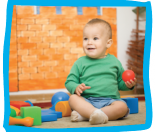Whether right or wrong, right from birth children are getting messages, both positive and negative, about what it means to be a boy or a girl. So can gender affect a child’s learning and play?
What sort of toys and gifts did your child receive on their first birthday? If they’re a boy it’s likely their gifts featured lots of blue, pictures of trucks and cool slogans on tee shirts such as ‘here comes trouble’ or ‘little dude’.
If they’re a girl the gifts are likely to be fluffy and pink and include slogans such as ‘diva’ or ‘princess’.
Can gender affect a child’s learning?
As an inhome childcare teacher, I’ve learnt that gender affects a child’s learning by both nature and nurture.
A simple way of looking at the difference between the two is: nature is what is already there at birth – a child’s genetic make-up; nurture is the influence of our environment, from close relationships with family, the wider community and the world around us.
We can’t really change nature, but on the nurture side we have a lot of control.
How do we unknowingly promote stereotypes around gender?
Visit toy shops or large stores like the Warehouse and you will see aisles labelled ‘girls toys’ and ‘boys’ toys’. The girls’ aisles are filled with Barbie, cute animal toys, fairy outfits, tea sets and dolls. Boys’ aisles are jam packed with big trucks, dinosaurs, tool sets and super hero costumes.
This sends out a message of what is ‘appropriate’ to buy for each gender and what boys and girls ‘should’ like.
Unfortunately some children are given negative messages when they explore non-traditional toys. A boy who goes to play with a doll might be told by an older child or even an adult, “that’s a girl’s toy.”
Boys who put on some fairy wings might be told they look silly and to take them off. Sometimes nothing negative is said but exploring outside traditional gender roles is not supported. For instance, if they’re never bought a tea set, then how can they benefit from the language and social skills that are enhanced during this type of play?
With girls, it’s the same. They may not be told they can’t play with something, but also not given the opportunity to do so. A girl can’t learn about putting together a train set if they’re never given one, nor can they learn to use a hammer if there isn’t one in their environment. They’re now missing out on the small-motor, and hand-eye coordination skills enhanced through this play.
Why encourage girls to play with toys traditionally for boys?
As an adult I know I’m not very good at fixing things or putting things together. Could this have been changed if I had been given construction sets or toy tool sets as a child?
With no brothers, my sister and I were never bought these. Many of the toys in the ‘boys’ aisle’ develop math skills and problem solving skills as well as spatial awareness. Sports equipment too such as rugby balls and cricket bats extend important large and small-motor physical skills.
Why encourage boys to play with toys traditionally for girls?
Many nurturing qualities and language skills are developed through play areas traditionally thought of as ‘for girls’, such as dolls and family play.
Many boys will grow up and become father’s one day and benefit from the nurturing traits, including empathy, enhanced through play with dolls.
Children’s play choices and gender
The younger a child is, the more likely they are to play with a wider variety of toys.
While there are some preferences influenced by nature, young children have not yet been as influenced as their older peers with gender. This is why you will see 18 month old boys dressing up with little high heels or fairy wings, but you’re less likely to see a 5 year old boy do the same.
Very young children will play with what they want to play with without fear of what others will think or say.
We can make the most of this time by having lots of variety available for children in their play.
As a teacher for Footsteps, I take toys and learning resources in all curriculum areas regardless of gender. Both boys and girls are given train sets, digger trucks, art and collage sets, dolls, prams, tea sets, carpentry sets, science experiments, messy play, dress ups, instruments and more.
This enables them to explore new interests and challenges regardless of gender.
What can we do to reduce gender stereotypes and encourage our children to learn without bias?
- Go with your child’s interests rather than what you like or what you think they should like. This year my seven year daughter wanted a dinosaur party which was in contrast to the Barbie or fairy parties typical amongst her friends. However rather than try and change her mind or say “but wouldn’t you rather have a princess party”, we went with it and she had a great party.
- Mix different areas of play such as a tea set with sand play.
- When choosing books look for ones that show both genders in varied and positive roles such as men and women looking after a baby, being a doctor or teacher, being a superhero.
- Encourage quiet play with boys such as drawing and arts and crafts from a young age.
- Is it your daughter’s birthday coming up? Look at the toys she has. Are there construction sets such as Lego or wooden blocks? Does she have a soccer ball? This doesn’t mean she can’t have a My Little Pony too if that is what she wants, perhaps the blocks could be used to build a stable.
- Equally if it is your son’s birthday look in his room. Does he have an art set or easel? Does he have a doll? Although I did have to laugh when I gave my three year old son a baby doll for Christmas and he named it after a character from Star Wars! You can provide the learning opportunity but the child will still put their own individual stamp on it. That’s what makes them unique.
- Families with all daughters or all sons need to be particularly aware to choose a wide variety of toys as they don’t have a sibling of the opposite gender to watch and learn from or try out their toys.
- Let your children see you in non-traditional roles. This can be a challenge depending on how you have been raised and what opportunities you had as a child. Let your children see Mum fixing a leaking tap and perhaps Dad sewing on a button.
- As women, if we are not naturally sporty, we may need to remind ourselves to get out there and kick a ball around with our children or have a go at a carpentry based activity with our children such as making a letter box so children see the important women in their lives in different roles.
- Men don’t get off either! Dads who usually do lots of rough and tumble play or transport themed play could change it up with joining in with art with their children or washing a doll with their daughter or son.
I encourage you to allow your child to play with a variety of toys and ensure they don’t feel restricted by traditional gender roles from a young age. Gender can affect a child’s learning and play, but it’s our own gender bias that has the biggest influence.
You might also like to read our Benefits of creative play article, or check out our Toys for babies section.







Excellent article, thanks. Good to be reminded about being aware of the gendered ways we unintentionally steer our kids in that we could change.
Studies have shown that large dolls often act as companions for small girls which can really help if they are lonely at school or being bullied.